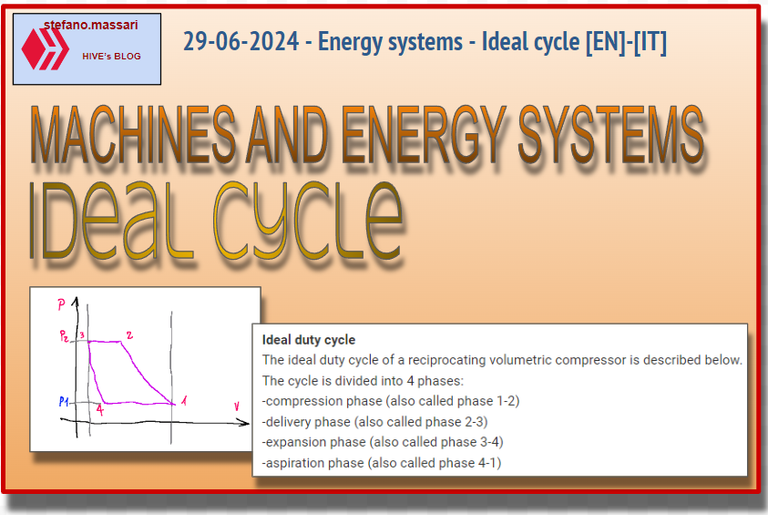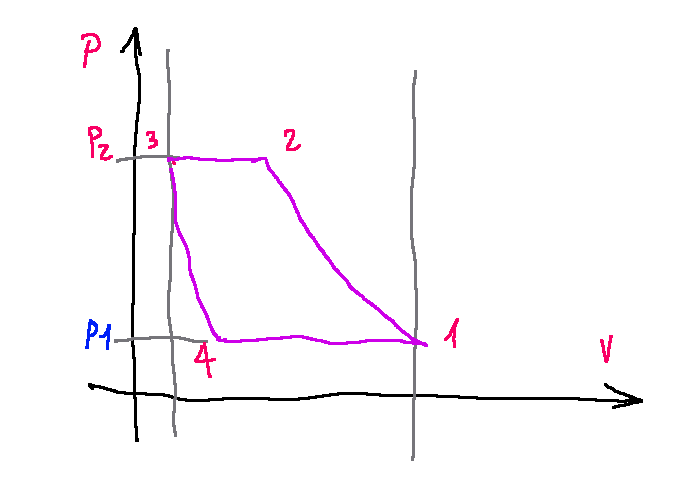29-06-2024 - Energy systems - Ideal cycle [EN]-[IT]

~~~ La versione in italiano inizia subito dopo la versione in inglese ~~~
ENGLISH
29-06-2024 - Energy systems - Ideal cycle [EN]-[IT]
Ideal cycle
The ideal work cycle of a reciprocating volumetric compressor is made up of 4 phases. The first and third phases are isentropic compression and the other is isentropic expansion.

In the graph we have v on the abscissae and p on the ordinate, where:
v = displacement
p = pressure
NOTE: In this case we are not referring to a thermodynamic cycle, but to a work cycle.
Hypothesis
The hypotheses that explain the ideal duty cycle of a compressor are the following:
Compression phase: isentropic compression up to pressure p2
Delivery phase: delivery at pressure p2
Expansion phase: isentropic expansion of the gas up to pressure p1
Suction phase: suction of gas at pressure p1
Ideal duty cycle
The ideal duty cycle of a reciprocating volumetric compressor is described below.
The cycle is divided into 4 phases:
-compression phase (also called phase 1-2)
-delivery phase (also called phase 2-3)
-expansion phase (also called phase 3-4)
-aspiration phase (also called phase 4-1)
Phase 1-2 is the compression phase where the piston is at bottom dead center and rises towards top dead center. The compressed volume will reach the p2 value which will cause the delivery valve to open.
Phase 2-3 is the delivery phase. Here it happens that when the valve (the delivery one) opens, the piston sends the gas present in the cylinder into the delivery environment until it reaches the top dead center.
Phase 3-4 is the expansion phase. Here, once the upper dead center has been reached, the piston reverses its stroke and begins to make the second stroke of the cycle. Remember that the cycle is completed with two strokes of the plunger. In this phase the delivery valve closes and the expansion phase of the gas which is contained in the dead volume up to the pressure p1 begins. This will cause the intake valve to open.
Phase 4-1 is the last phase. In this phase the piston finishes the second stroke towards the bottom dead centre, sucking gas at pressure p1 from the suction environment. Once the piston reaches the bottom dead center it will begin a new compression phase, i.e. a new cycle will begin.
Conclusions
The ideal work cycle of a reciprocating volumetric compressor is made up of 4 phases. It is characterized by a compression phase up to the top dead center and an expansion phase up to the bottom dead center. With 2 strokes of the piston the work cycle of a reciprocating volumetric compressor is achieved,
Request
Have you ever studied reciprocating volumetric compressors at school? Have you ever used an air compressor in your life?

ITALIAN
29-06-2024 - Sistemi energetici - Ciclo ideale[EN]-[IT]
Ciclo ideale
Il ciclo di lavoro ideale di un compressore volumetrico alternativo si compone di 4 fasi. La prima e la terza fase sono una compressione isoentropica e l’altra un espansione isoentropica.

Nel grafico abbiamo v sulle ascisse e p sulle ordinate, dove:
v = cilindrata
p = pressione
NOTA: In questo caso non facciamo riferimento ad un ciclo termodinamico, ma ad un ciclo di lavoro.
Ipotesi
Le ipotesi che spiegano il ciclo di lavoro ideale di un compressore sono le seguenti:
Fase di compressione: compressione isoentropica fino alla pressione p2
Fase di mandata: mandata a pressione p2
Fase di espansione: espansione isoentropica del gas fino alla pressione p1
Fase di aspirazione: aspirazione del gas a pressione p1
Ciclo di lavoro ideale
Qui di seguito è descritto il ciclo di lavoro ideale di un compressore volumetrico alternativo.
Il ciclo si divide in 4 fasi:
-fase di compressione (detta anche fase 1-2)
-fase di mandata (detta anche fase 2-3)
-fase di espansione (detta anche fase 3-4)
-fase di aspirazione (detta anche fase 4-1)
La fase 1-2 è quella di compressione dove lo stantuffo si trova al punto morto inferiore e sale verso il punto morto superiore. Il volume compresso raggiungerà il valore p2 che provocherà l’apertura della valvola di mandata.
La fase 2-3 è la fase di mandata. Qui avviene che all’apertura della valvola (quella di mandata) lo stantuffo provvede ad inviare il gas presente nel cilindro nell’ambiente di mandata fino a raggiungere il punto morto superiore.
La fase 3-4 è la fase di espansione. Qui raggiunto il punto morto superiore lo stantuffo inverte la corsa ed inizia a fare la seconda corsa del ciclo. Ricordiamo che il ciclo viene completato con due corse dello stantuffo. In questa fase la valvola di mandata si chiude ed inizia la fase di espansione del gas che è contenuto nel volume morto fino alla pressione p1. Questo provocherà l’apertura della valvola di aspirazione.
La fase 4-1 è l’ultima fase. In questa fase lo stantuffo finisce la seconda corsa verso il punto morto inferiore aspirando dall’ambiente di aspirazione gas a pressione p1. Uno volta che lo stantuffo giunge al punto morto inferiore inizierà una nuova fase di compressione, cioè inizierà un nuovo ciclo.
Conclusioni
Il ciclo di lavoro ideale di un compressore volumetrico alternativo si compone in 4 fasi. Esso è caratterizzato da una fase di compressione fino al punto morto superiore e da una fase di espansione fino al punto morto inferiore. Con 2 corse dello stantuffo si realizza il ciclo di lavoro di un compressore volumetrico alternativo,
Domanda
Avete mai studiato a scuola i compressori volumetrici alternativi? Avete mai usato un compressore d'aria nella vostra vita?
THE END
Congratulations @stefano.massari! You have completed the following achievement on the Hive blockchain And have been rewarded with New badge(s)
Your next target is to reach 1700 posts.
You can view your badges on your board and compare yourself to others in the Ranking
If you no longer want to receive notifications, reply to this comment with the word
STOPCheck out our last posts:
It's interesting how reciprocating compressors follow such precise cycles with isentropic phases, I really need to go back to my physics books now hahaha !LOLZ
Sì, l'ho usato.
Ehi, mi manca la tua musica, ma non sono nessuno in grado di cambiare il modo in cui svolgi il tuo lavoro.
Ma se mi mancano la tua musica, i tuoi dipinti, ecc, in questo modo posso commentare qualcosa di più interessante.
Ti auguro una notte felice
!discovery 30
This post was shared and voted inside the discord by the curators team of discovery-it
Join our Community and follow our Curation Trail
Discovery-it is also a Witness, vote for us here
Delegate to us for passive income. Check our 80% fee-back Program
The graph seem complex to me though
It was an amazing class still
Keep up the good work. 👏🎵
Dear beloved Hive creator,
Coding poet Gudasol here to support you sharing your art + life on Hive.
As a fellow creator, I know how hard it is to get the word out there.
I built cXc.world to help creators like us get more support from the blockchain community + beyond.
Share your music on cXc.world, and copy the Markdown for a easy post includes embedded players for Spotify, Youtube, Soundcloud.
That way, you can earn HIVE + stack streams on centralized platforms, as they do still matter.
Not a music creator? No problem. You can still use cXc.world to find + share music you love.
What's next?
Preview the next evolution of cXc, Tetra.earth.
Expose local music from your area!
We're helping grassroots musicians, and you can too by adding their music (no sign up or WAX account required).
Join our community 🐬
Find fellow music lovers in cXc's Discord
Bad news: Saying see you later to Hive! 👋
We didn't get the needed support to continue cXc.world on Hive, as our DHF proposal lacked votes, but [Good News Everyone] cXc.world will add a Markdown copy button, allowing you to easily share your music + music you find on Hive.
For now, we're on WAX, with tools you can use to mint your own Music/Media NFT collection.
Curious about the future of Earth + ET relations? New economic systems?
Find more apps + art from Gudasol
Want to build tools like I used to share this?
I'd love to show you some tips on AI Code generation